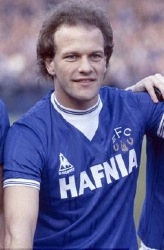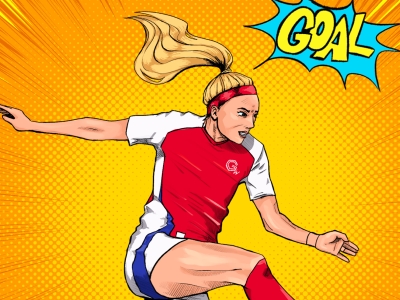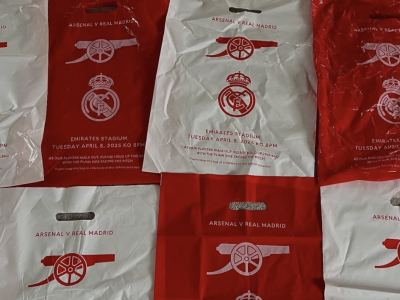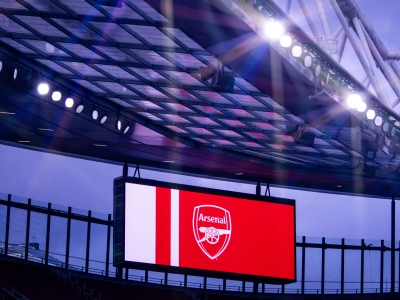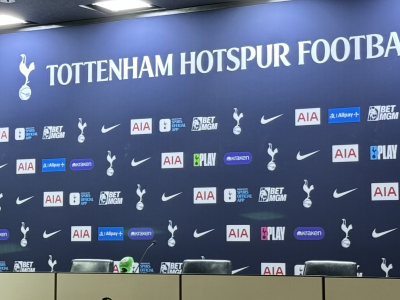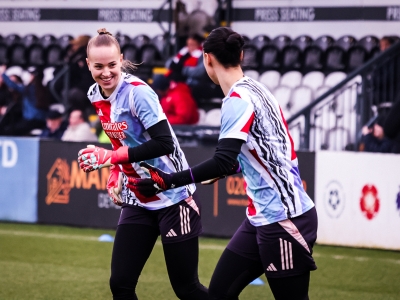As Arsene Wenger said in May 2002 ‘everyone thinks he has the prettiest wife at home’. After 26 years of footballing marriage to the Arsenal I can say that we’re still very much an item and never have I felt the urge to stray. However – like with many a footballer, the fact you’re happily married doesn’t stop your eye being caught by what else is one the market. The difference being of course – unlike Footballers – you never actually do stray. And of course, like many a great plutonic chemistry, it never actually has to be consummated. The list is endless – Johnny Vaughan and Denise Van Outen, Chris Evans and Gaby Roslin, Anne Diamond and Nick Owen, Jane Torville and Christopher Dean, Gary Neville and David Beckham….despite the chemistry that was there, no physical union ever happened between them. In fact, I’m no Dr Ruth, but such things may well be healthy in a relationship. Every time you felt something was missing in the relationship that was present elsewhere, in time you realise the very same quality you admired outside the relationship was there with your true love all along, just waiting to surpass the thing that briefly caught your eye elsewhere.
In my 26 year marriage to the Arsenal, here lies a few of the plutonics that briefly caught the eye. They all have a common theme: They’re not from our end of the country, no-one round our way supports them and more often than not, they were not realistic challengers for the trophies (or lack of) that we were challenging for.
Everton 1985-88
It’s hard to explain to anyone born ten years after me what football coverage of English top tier was like on TV way back in the mid-80s, before the saturation coverage of today. There was never more than about five or six live games a year, highlights only ever showed about three games and in the first half of 1985/86 football wasn’t even on TV in any shape or form. Arsenal were very poor, unsuccessful and lacked any degree of televisual appeal. When it came to the business end of the season (a term that seems to crop up constantly these days – it gets on my tits too, but for the purpose of this article I’ll use it anyway) the TV companies only seemed to be interested in who was up for the cups, who was top of the league or who was going down – Arsenal were never in either of those brackets and hence TV took little interest. At the end of my first season as an Arsenal fan one team seemed to dominate on all fronts and hence the TV was very interested in them – Everton
As a neutral it was OK to like Everton. Everyone round our way was West Ham or Tottenham – for the gloryhunters supporting Northern sides it was Liverpool or United. Everton had no supporters in Essex; you could back them for the League, the Cup and Europe guilt free. They were also great to watch, leading the line had been the future of British TV punditry – first Andy Gray and then replacing him a young Gary Lineker the following year. Also many of British football’s up and coming bright young things – Trevor Steven, Gary Stevens, Kevin Ratcliff, Kevin Sheedy, Kevin Richardson, Graeme Sharp, Paul Bracewell, Peter Reid and the world’s number one between the sticks, Neville Southall. 1985 was my first Cup Final, from the local corner shop I was bought a copy of the FA Cup match day programme and a packet of Everton Mints. They were denied an historic treble by a Norman Whiteside goal, but won the league with a then record of 90 points and three days before meeting United in the Cup Final won the ECWC in Rotterdam. And you could cheer their success with a small crumb of comfort – early on in the season we actually did beat them 1-0 at Highbury.
The following year they were runners up in both the League and Cup and then another League title in 1987 (of which Arsenal was in the running for as late as March). However if any team had a valid rational reason to be bitter and resentful of their local rivals it was Everton. Their triumph in Europe was the last of any English side before the Heysel disaster just days later, of which Liverpool fans’ misdemeanours were a major factor, if not the major factor in the tragedy. All English sides were banned, but Everton undoubtedly were hit the worst. Not only denied the chance of challenging for the European Cup at a time when the English sides dominated, Howard Kendall left in 1987 to try his luck in Euro competition with Athletic Bilbao. As also did Lineker to Barcelona after Mexico 86, plus Gary Stevens and Trevor Steven heading north of the border to Rangers in 1988 and 1989 respectively.
While Everton fell down Football’s pecking order, Arsenal were waving by in the opposite direction and the two sides had significant meetings on the way. Many of my acquaintances over the years, who I’ve only known since adulthood, have accused my support of Arsenal of being some sort of worshipping at the altar of success, in my defence my Highbury debut in November 1985 came 7 days after Arsenal were slaughtered 6-1 away at Everton. This game was possibly the last stand for many of the old guard and hereafter saw the trickle through of Don Howe’s youth policy that George Graham was to utilise over the coming seasons. In the weeks that followed Rix was axed for Hayes, Caton for Keown, Woodcock for Quinn, with Rocastle and Tony Adams pushing on the fringes.
In the following season, the first big win of the Graham era came at Goodison Park in October 1986. Everton had outplayed Arsenal until Steve Williams banged in a 30 yard screamer. Eighteen months later, Everton now under the stewardship of the unspectacular Colin Harvey met defending holders Arsenal in the semi-final of the League Cup. Arsenal came away from Goodison with an excellent 1-0 win live on ITV’s Sunday Afternoon Big Match ( http://www.youtube.com/watch?v=y2YUkVY2BwM&feature=related). The 2nd Leg at Highbury saw a thumping 3-1 win for Arsenal that really saw the emergence of Michael Thomas as a first teamer in Arsenal’s midfield. By the following season, where Kendal’s Everton had previously been the perennial title challengers to Liverpool, it was now George Graham’s Arsenal.
Nottingham Forest 1988-1993
Rarely did Brian Clough ever have a kind word for the Arsenal. In the 80s he once referred to us as a pub side. On Arsenal beating Forest’s 42 game unbeaten run he paid the side a glowing tribute, though still added that ‘it sticks in the craw that it’s Arsenal, because no-one like Arsenal. I was brought up hating Arsenal’. It is however, very difficult to not like Cloughie. He insisted on football to be played on the ground because ‘if god wanted football played in the clouds he’d put grass up there’. Staunchly a man of the people too, Clough remained socialist giving his backing to the striking miners, the NHS and on making a speech to a TUC conference stated ‘is there enough jobs of all of Britain’s talent? Well there always seems to be enough jobs for all the s**thouses!’ As Arsenal became a dominant force in the League they were usually out of the domestic cups early, meaning you had to look elsewhere for someone to cheer on to Wembley as a neutral and it usually was Fred Beardsley’s old benevolent shirt-donating side of 125 years ago.
Clough’s side were also a sticky hurdle for Arsenal too, knocking us out of the FA Cup in 1988 and beating us at Highbury 1-3 in the league in early 1989. Also in 1991, one of the most entertaining Arsenal defeats I’ve witnessed was when we were close to pulling back a 3 goal deficit only to lose 2-3. In the reverse that season Arsenal did complete the comeback, drawing 3-3 after being 1-3 down. They were however never ever challengers for the league at this point, despite winning plaudits for their excellent football they never finished above third (sound familiar?). Like Wenger of today, Clough was once championship material though by the late 80s had to settle with good football and the league cup as a substitute. But in Nottingham any years B.C. stood for Before Clough and there simply never was the same expectation as with Arsenal, which is probably why by 1993 Clough was allowed to drag them back to the obscurity he plucked them from in the mid-70s.
Clough’s latter years did however bring them back to back League Cup triumphs, as it did a decade earlier, plus the long forgotten Simod Cup which was invented to fill the post-Heysel loss of European football. Much praise also needed for their defeat of Liverpool to hand Arsenal the title in 1990/91 and finishing that season in blistering style with a 7-0 win over Chelsea, though quite possibly burning themselves out for the 1991 ‘Gazza’ Cup Final which the lost to North London’s other side 1-2.
Victories against Forest were also a good yardstick for Arsenal’s success, the Littlewoods Cup Quarter Final of 1987 win at Highbury with a great Charlie Nicholas goal and Lukic penalty save from Pearce. Also in November 1988 a storming televised 4-1 win at the City Ground was a clear sign that Arsenal meant business that year. In Arsenal’s double cup year of 1992/93, they defeated Forest in both the League and FA Cups at Highbury along the way. By the end of that season Cloughie bowed out of football, relegating Forest to the second tier, by which time both he and Forest were a mere shadow of their much missed former greatness. And from hereafter life for either was sadly never really the same again.
(Ed’s Note – Part 2 follows tomorrow)

